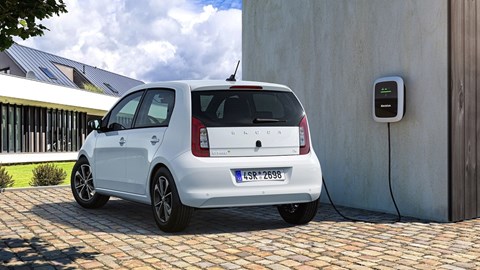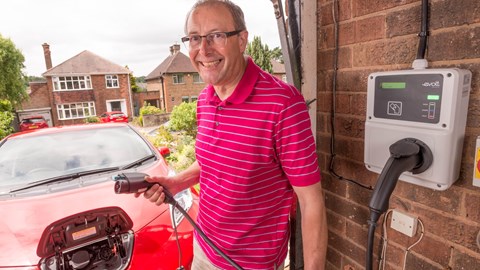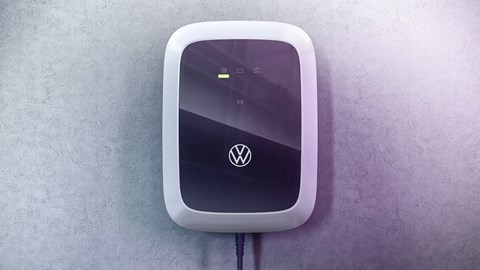► Some homeowners soon ineligible for grant
► Flat owners or property renters can still apply
► Changes coming into force 30 April 2022
The government will soon alter its Electric Vehicle Homecharge Scheme (EVHS). Until now, almost anyone in the UK with a plug-in hybrid or an electric car could apply for a grant of up to £350 to offset the cost of installing a wallbox charger at their home – but the terms of eligibility are about to change.
From April 2022, homeowners living in bungalows and detached, semi-detached or terraced houses will no longer be able to apply for the grant. However, the initiative will still be available for everyone living in rental accommodation and homeowners living in flats, providing they have access to a dedicated off-street parking space at which the charger can be installed.
The April cut-off date means house owners still have a small window of opportunity to get their hands on a discounted wallbox. To pass through the system, though, the installation of the charging point will need to be completed by 31 March and the claim submitted to the DVLA by 30 April. No pressure, then…
Best electric cars 2022
What are electric cars really like to live with?
While the EVHS grant’s housing criteria is about to change, the vehicle terms have remained the same. To be eligible for the scheme, you need to own at least one of the plug-in hybrid or fully electric vehicles on this list. Most PHEVs and EVs built after October 2016 qualify.

This change in regulations will make it slightly more expensive for drivers looking to make the shift to electric motoring. Wallbox chargers cost an average of £1,000 to install – and now, many EV buyers will need to foot the entire bill themselves.
A cheaper option would be to rely on a three-pin socket or a commando socket but, for reasons we’ll explain further down this article, they’re not ideal options for prolonged use. Scroll down for a full breakdown of the different methods for charging an electric car at home.
How much does it cost to charge an electric car?
CAR’s Guide To Home Charging
Three-pin plug socket (max 3kW)
The simplest and cheapest option for charging an EV at home is a regular three-pin socket. It might require a few compromises, such as running your cable through an open window or installing a waterproof socket outside – but you won’t need to open your wallet too far to get started.
The biggest drawback is the speed. It’s the slowest possible charging rate. Charging a large battery pack, such as the 64kWh unit on a Kia e-Niro, will take around 30 hours from empty. Have something with an enormous battery, like a Porsche Taycan or the new Mercedes EQS? Forget it.

Most manufacturers recommend three-pin charging as an absolute last resort. Some household sockets also aren’t rated for long periods of continuous heavy usage – especially if you’re using them with an extension cable. As a result, manufacturers are increasingly refusing to supply three-pin chargers as standard equipment with new PHEVs and EVs.
Home wallbox (3kW – 22kW)
A home wallbox is the type of charger you’ll get as part of the government’s EVHS grant. It’s a separate box which is wired directly to your homes electrical system. Normally, they’re installed by the companies that supply them, although they can be connected by specialist electricians, provided they have the proper qualifications.
The most basic home wallboxes can charge at 3kW, which is about the same sort of speed you’ll get from a regular mains socket. The most common units, though – including the ones supplied free with some electric cars – will charge at 7kW. This will cut charging times in half and then some compared with a three-pin socket, giving realistic overnight charges for most electric cars on the market.

How much faster you can charge depends on the electricity supply to your house. Most houses have what’s known as a single-phase connection, but some modern properties or businesses will have a three-phase connection.
These can support wallboxes of 11kW or even 22kW – but it’s rare for a normal family home. You can usually check if your property has a three-phase supply by the number of 100A fuses in your fuse box. If there’s one, you’re on a single-phase supply; if there’s three, you’re on three-phase.
Wallboxes can be supplied “tethered” or “untethered.” A tethered connection has a captive cable which stores on the unit itself, whereas an untethered box simply has a socket for you to plug your own cable into. The latter looks tidier on the wall, but you will need to carry a charging cable around with you.
Commando socket (7kW)
A third option is to fit what’s known as a commando socket. These will be familiar to caravanners – they’re large, weatherproof sockets which take up significantly less space on an exterior wall than a wallbox, making for somewhat of a tidier installation. They’re also cheaper and simpler to install than a wallbox, but it’s still worth getting an EV-certified electrician to fit it for you.
There is a drawback to commando sockets, though. They’re not compatible with a standard charging cable, so you’ll have to buy a specialist conversion cable with a built-in charging controller. These cables are also much more expensive than a conventional wallbox cable – sometimes as much as a few hundred pounds.
Home charging vs. public charging
Thankfully, the UK’s public charging network is expanding, so it’s not the end of the world if you can’t quite afford a wallbox charger at the minute. Plenty of petrol stations now also feature rapid chargers, while slower charge points are springing up on residential streets around the UK.
There’s no arguing with the convenience of a home charger, though. Simply plug your car in when you get home and, by the time you wake up the next day, you’ll have a full battery.
Charging at home is also much less expensive than using public stations, especially if you plug in at night when tariffs are cheaper. Indeed, some “agile” energy tariffs allow you to top up your car’s battery for pennies. Sounds good, right?

Of course, home charging points aren’t suitable for everyone. For a start you’ll need your own off-street parking – either a driveway or a garage – or else your charging cables will pose a very real trip hazard to any passers-by.
And even though the government’s EVHS grant now favours those living in rented accommodation, you might struggle to convince your landlord to install a charge point. It’s worth pressing the matter, though, because a correctly fitted wallbox could add value to the property.
Electric vehicle charge point installers
Many plug-in cars are offered with a free home wallbox when you purchase them or take out a finance package. This is great news and should be seen as a real positive – after all, electric chargers aren’t limited to just one car, and having an up-to-date wallbox installed means you’re set up for many years to come.
If your car doesn’t come with a charging point included, you’ll need to contact a dedicated fitter. Some of these are big names you might have heard of before – BP Chargemaster, Pod Point or myenergi to name a few. A list of authorised installers is available on the GOV.UK website.
An installation will usually include a home consultation visit, to assess the suitability and ensure you meet the criteria for the homecharge grant. Installation times obviously vary depending on where the point will be located and where the electricity supply enters your house.
Non-EV Best Car Battery Chargers